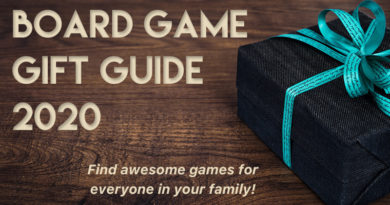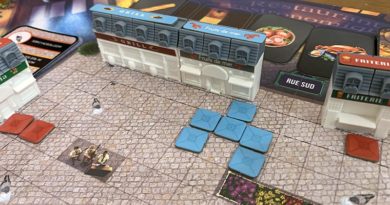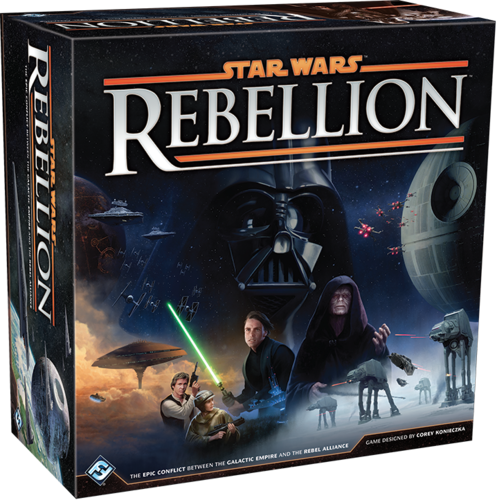Codenames enters the Wizarding World!
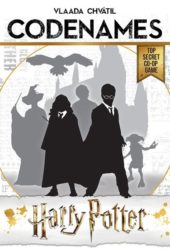
We’re big Codenames fans.
Which means we’ve also been swept up in playing all the iterations of Codenames over the years.
Well, there is one version of Codenames we haven’t played — because we have absolutely no interest in the salacious, “adult” version, Codenames: Deep Undercover.
But we have played every other version and have enjoyed most of them. The only one we didn’t enjoy is the Marvel version mainly because we don’t know most of the characters in that universe. So figuring out clues to tie them together was way too hard for us.
Good thing that’s not the case for the version we’re reviewing today, Codenames: Harry Potter by USAopoly!
That’s because we’re also big Harry Potter fans.
So mixing Codenames and Harry Potter should be a slam-dunk of fun, right?
Let’s find out…
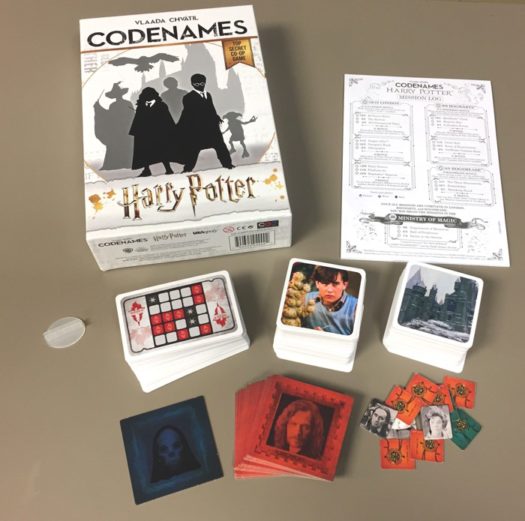
How to play Codenames: Harry Potter
To those who are familiar with how to play Codenames, you’ll find Codenames: Harry Potter a quick breeze to dive into. Yet, even though the core gameplay is Codenames through and through, there are still a number of differences that give it a good twist for the theme.
Codenames: Harry Potter is actually a cooperative version of Codenames. Instead of there being two teams that race to find secret operatives among the grid of cards on the table, in Codenames: Harry Potter, the two teams work together to discover all the members of the Order of the Phoenix.
The game was actually designed as a 2-player game like Codenames: Duet. But it can still be played with two teams if more people want to play. (So we’ll use the term “team” throughout.)
In the original game (and Pictures, Disney, and Marvel), clue-givers for both teams sit on one side of the table and look at the key card that shows where each of their operatives are located. But in Codenames: Harry Potter, the key cards are double-sided. A key card is placed in the center of the table so each team can only see their side of the card.
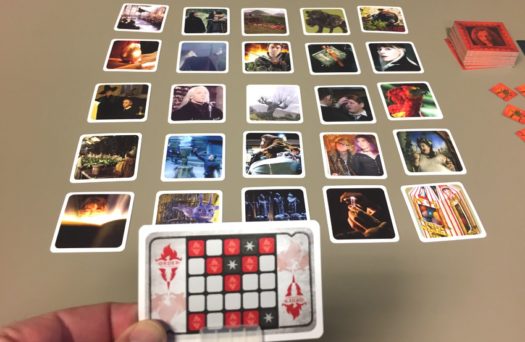
Each side of the card shows 9 spots of Order of the Phoenix members (marked in red) and 3 spots that represent Death Eaters (must avoid those black spots). Each side of the card is different in the way it’s laid out. So players will be giving clues for different Code cards, though 3 Order of the Phoenix members and 1 Death Eater will overlap.
Players set out a grid of 25 Code cards on the table and the marks on the key cards match the 5×5 grid of Code cards. Since the cards are double-sided, players can choose to play with either the picture side or the word side — or a combination of both.
They also set out 10 Time-Turner tokens that are used to mark the passing of time (since players have limited time to win).
Players take turns giving the other team clues. A clue is 1 word and 1 number. The number tells how many Code cards relate to the word clue.
The other team then guesses the Code cards by touching them, one at a time. If the Code card is an Order of the Phoenix member, the clue-giving team places an Order of the Phoenix card over it. The team can continue guessing more cards by touching them likewise. Or they can choose to stop. Once done, that team takes a Time-Turner token.
If the card touched is a Death Eater, the Death Eater card is placed over it and everyone loses.
If the card touched is a blank spot on the key card, the clue-giving team places a Time-Turner token on that card with the Ministry of Magic member face up and the black arrow on that token pointing toward the team that guessed wrong. The token is placed like this because that Code card may still be something (Order of Phoenix member or Death Eater) for the other team. Running into a Ministry of Magic person ends the turn.
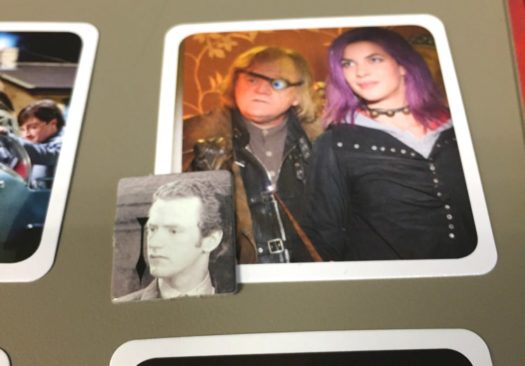
Every turn ends by taking a Time-Turner token – either in front of the guessing team when they choose to stop or on a Code card because they met up with a Ministry of Magic person.
Play continues this way until the teams jointly discover all 15 Order of the Phoenix members (win) or hit a Death Eater (lose).
However, if players have used up their last Time-Turner token and there are still Code cards to be guessed, the game goes into Sudden Death. When this happens, no one gives any more clues. Players simply use the information they already have to start touching more cards. Teams can guess in any order and don’t have to alternate turns. Cards touched are marked in the same way. However, any guess that doesn’t find a member of the Order of the Phoenix results in a loss.
And that’s the core of playing Codenames: Harry Potter.
However, that’s not all there is to the game. Players can also embark on missions…
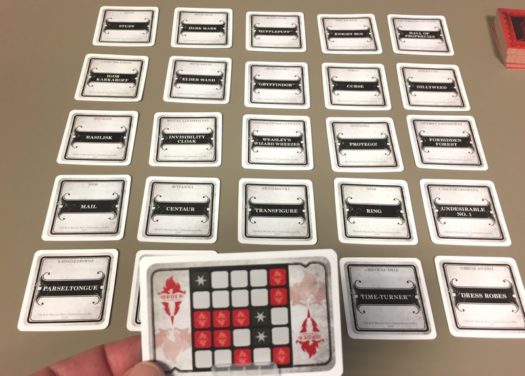
Missions
As described above, a standard game of Codenames: Harry Potter includes 10 Time-Turner tokens. However, the game also includes 2 additional Time-Turner tokens if you’re struggling and need more turns in a game.
But that’s not all there is to the game either.
Players will encounter different challenges by attempting Missions using the Mission Logs in the game.
The game comes with a ton of mission log sheets. And the various sections of a log sheet are grouped by location (London, Hogwarts, Hogsmeade, Ministry of Magic). Within each location, there are sets of 3 missions for players to take on.
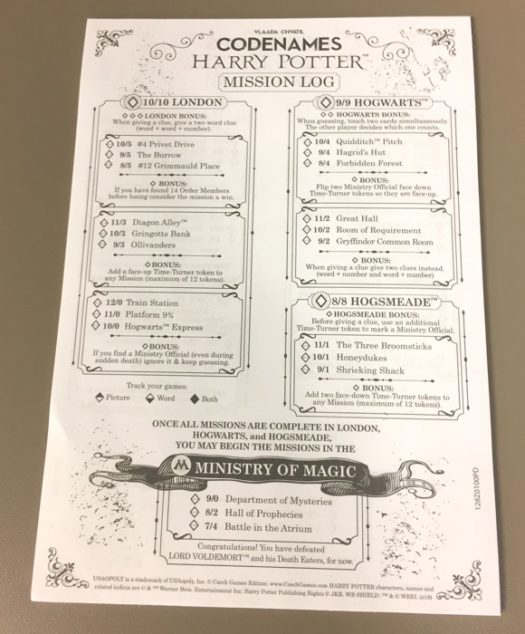
For example, in the London area, players may choose to attempt the Diagon Alley, Gringotts Bank, and Ollivanders missions.
The numbers next to the missions are essentially the difficulty.
The first number is the number of Time-Turner tokens in that game. The second number is the number of acceptable mistakes (Ministry of Magic side up). For example, in the Ollivanders mission, players only get 9 Time-Turner tokens and only 3 of them can be used as Ministry of Magic side up (used when someone touches a blank Code card).
Once players use up the allotted Ministry of Magic tokens, wrong guesses are penalized. Thereafter players must place 2 Time-Turner tokens on incorrectly guessed cards.
When players successfully complete a mission, they fill in the diamond next to that mission.
Once players successfully complete 3 missions in a grouping, they unlock the Bonus listed for that grouping. They can use this bonus ability on any future game. But once used, they must shade in the diamond next to the Bonus ability to show it’s been used.
After players have successfully completed all missions in London, Hogwarts, and Hogsmeade, they can move on to the very challenging Ministry of Magic missions.
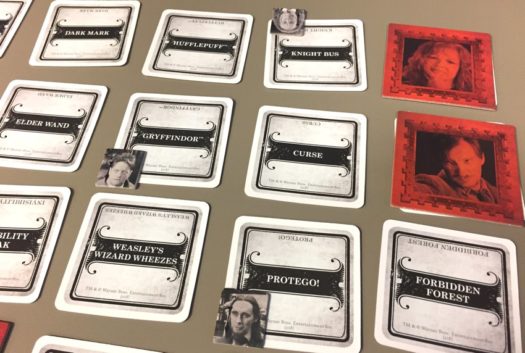
Can the whole family enjoy Codenames: Harry Potter?
This game is obviously targeted at Harry Potter fans.
Though similar to us playing Codenames: Marvel, if you don’t know the characters and stories, you’re going to have a real struggle on your hands. And the game won’t be very enjoyable.
But if you enjoy Harry Potter, Codenames: Harry Potter can be a fun game for all.
Yet having played Codenames in many versions, we’ve discovered there are some people who get stressed out playing Codenames. Trying to think of clues to tie cards together can be a challenge. And they don’t like that pressure.
They may like playing Codenames as long as they’re part of the group guessing the cards. But they don’t like coming up with clues.
So when you’re playing a 2-player game where each player must give clues to the other player, those players that feel too much pressure won’t find the game fun.
Otherwise, working together to find the Order of the Phoenix members is great fun.
In fact, the cooperative nature of Codenames: Harry Potter is an absolute perfect fit for the theme!
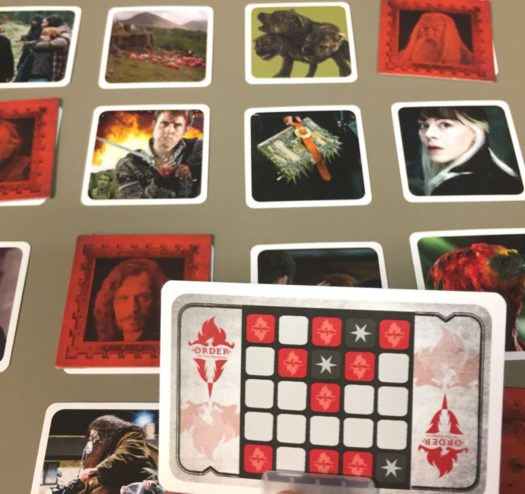
When we first heard they were making a Harry Potter version, we wondered how it would work competing against teams. Would each team be a Hogwarts house competing for House Points against each other?
We were very happy when we found out that it’s a cooperative game.
As such, it falls right into the same level of love we give Codenames: Duet.
That being said, we still find Codenames: Harry Potter to be very challenging.
We prefer playing with the Code cards picture side up. While we find that easier than the word side, it’s still a big challenge because so much of the artwork is dark.
The pictures come from the movies. And if you know the movies, you’ll also know that a lot of the settings are darkly lit. And that means with 25 cards in a grid with similar color tones, you’re going to have a hard time finding words to tie multiple cards together without mixing in those you don’t want the other person to guess.
The other downside to playing with photos from movies is that it can be hard to break your thoughts away from the connotations you have with that scene. And that leads to more challenges with thinking of single words to tie 2 or more cards together.
As such, our games of Codenames: Harry Potter tend to last longer than we’re used to.
It’s not that we’re not willing to tackle that challenge, but it’s just that we need to know what we’re setting ourselves up for when we play it.
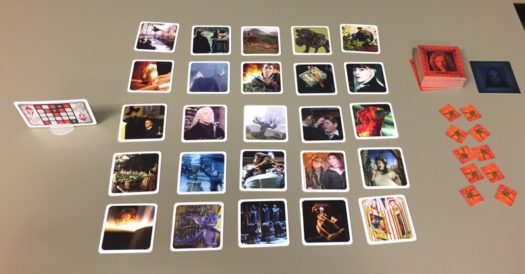
How does Codenames: Harry Potter score on our “Let’s Play Again” game meter?
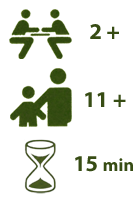 Codenames: Harry Potter scores well on our “let’s play again” game meter. It’s a very solid Codenames game and it offers a fun challenge with a theme we love.
Codenames: Harry Potter scores well on our “let’s play again” game meter. It’s a very solid Codenames game and it offers a fun challenge with a theme we love.
It’s also a game my wife and I can enjoy playing together while the kids are out at their various activities. (Which happens more and more with teenagers.)
The addition of Missions with varying levels of challenges also drives us to want to play the game more. It seems like the mission log with accomplishments to mark off is setting us up to have to play more. But we don’t mind — it works well.
We want to complete sets of missions. And if we fail one mission, we want to try it again. So that definitely leads us in to calling out “let’s play again” more that we might normally do.
(We also find ourselves wanting to watch the movies again…)
Having played 6 different versions of Codenames, here’s our current ranking (with most favorite listed first).
- Codenames: Pictures
- Codenames: Duet
- Codenames: Harry Potter
- Codenames: Disney
- Codenames
- Codenames: Marvel
If you haven’t yet played Codenames, you’re missing out. With various themed versions, grab a copy of the one that appeals to you and have a great time!
We’d like to thank Miniature Market for a review copy of Codenames: Harry Potter.



